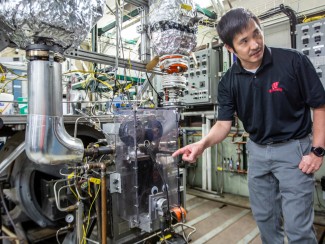
Multilayer plastic materials are ubiquitous in food and medical supply packaging, particularly since layering polymers can give those films specific properties, like heat resistance or oxygen and moisture control.
But despite their utility, those ever-present plastics are impossible to recycle using conventional methods.
Currently, about 100 million tons of multilayer thermoplastics—each composed of as many as 12 layers of varying polymers—are produced globally per year. Forty percent of that total is waste from the manufacturing process itself, and because there has been no way to separate the polymers, almost all of that plastic ends up in landfills or incinerators.
Now, University of Wisconsin–Madison engineers have pioneered a method for reclaiming the polymers in these materials using solvents, a technique they’ve dubbed Solvent-Targeted Recovery and Precipitation, or STRAP processing. Their proof-of-concept is detailed in the Nov. 20, 2020, issue of Science Advances.
By using a series of solvent washes guided by thermodynamic calculations of polymer solubility, George Huber, a professor of chemical and biological engineering at UW–Madison, his colleague Reid Van Lehn, and their students used the STRAP process to separate the polymers in a commercial plastic composed of polyethlylene, ethylene vinyl alcohol, and polyethylene terephthalate.

The result? The separated polymers appear chemically similar to those used to make the original film.
The team now hopes to use the recovered polymers to create new plastic materials, demonstrating that the process can help close the recycling loop. In particular, it could allow multi-layer plastic manufacturers to recover the 40 percent of plastic waste produced during the production and the packaging process.
“We’ve demonstrated this with one multilayer plastic,” says Huber. “We need to try other multilayer plastics and we need to scale this technology.”
But as the complexity of the multilayer plastics increases, so does the difficulty of identifying solvents that can dissolve each polymer. That’s why STRAP relies on a computational approach used by Van Lehn called the COnductor-like Screening MOdel for Realistic Solvents (COSMO-RS) to guide the process.

COSMO-RS is able to calculate the solubility of target polymers in solvent mixtures at varying temperatures, narrowing down the number of potential solvents that could dissolve a polymer. The team can then experimentally explore the candidate solvents. “This allows us to tackle these much more complex systems, which is necessary if you’re actually going to make a dent in the recycling world,” says Van Lehn.
The goal is to eventually develop a computational system that will allow researchers to find solvent combinations to recycle all sorts of multilayer plastics. The team also hopes to look at the environmental impact of the solvents it uses and establish a database of green solvents that will allow them to better balance the efficacy, cost and environmental impact of various solvent systems.
The project stems from UW–Madison’s expertise in catalysis. For decades, the university’s chemical and biological engineering researchers have pioneered solvent-based reactions to convert biomass—like wood or agricultural waste—into useful chemicals or fuel precursors. Much of that expertise translates into solvent-based polymer recycling as well.
The team is continuing its research on STRAP processing through the newly established Multi-University Center on Chemical Upcycling of Waste Plastics, directed by Huber. Researchers in the $12.5 million U.S. Department of Energy-funded center are investigating several chemical pathways for recovering and recycling polymers.
George Huber is the Richard L. Antoine Professor and Reid Van Lehn is the Conway Assistant Professor in the Department of Chemical and Biological Engineering at UW–Madison.
Theodore Walker, Nathan Frelka, Zhizhang Shen, Alex Chew, Jessie Banick, Min Soo Kim and James Dumesic of UW-Madison also contributed to this paper.
This research was supported by the Great Lakes Bioenergy Research Center, U.S. Department of Energy, Office of Science, Office of Biological and Environmental Research under Award Numbers DE-SC0018409.





